Synthesis, Photophysical Mechanisms, and Applications of Luminescent Organic–Inorganic Hybrid Metal Halides
Abstract
1. Introduction
2. Structural Characteristics and Stability of Organic–Inorganic Hybrid Metal Halides
2.1. Structural Characteristics
2.2. Stability
3. Common Techniques of Organic–Inorganic Hybrid Metal–Halide Crystals
3.1. Solution-Cooling Method
3.2. Solvent Evaporation Method
3.3. Solvent Diffusion Method
3.4. Antisolvent Crystallization
3.5. Mechanochemical Method
4. Photophysical Mechanisms of Organic–Inorganic Hybrid Metal Halides
4.1. Band-Edge Exciton Dynamics
4.2. Ion Emission
4.3. Defect Emission
4.4. Self-Trapped Exciton Emission
5. Applications of Organic–Inorganic Hybrid Metal Halides
5.1. Light-Emitting Diodes
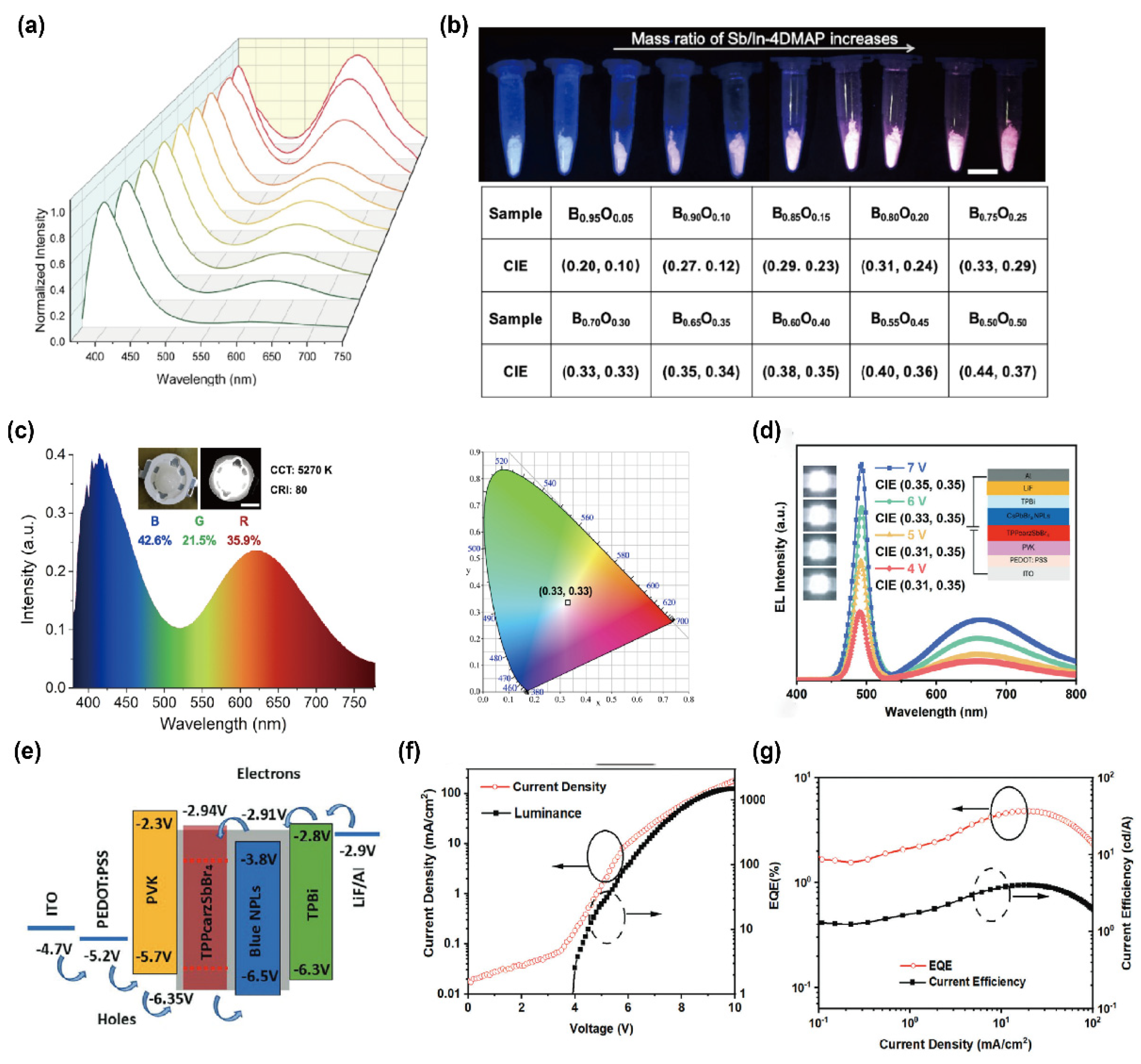
5.2. Information Encryption and Anti-Counterfeiting
5.3. Luminescent Probes and Sensors
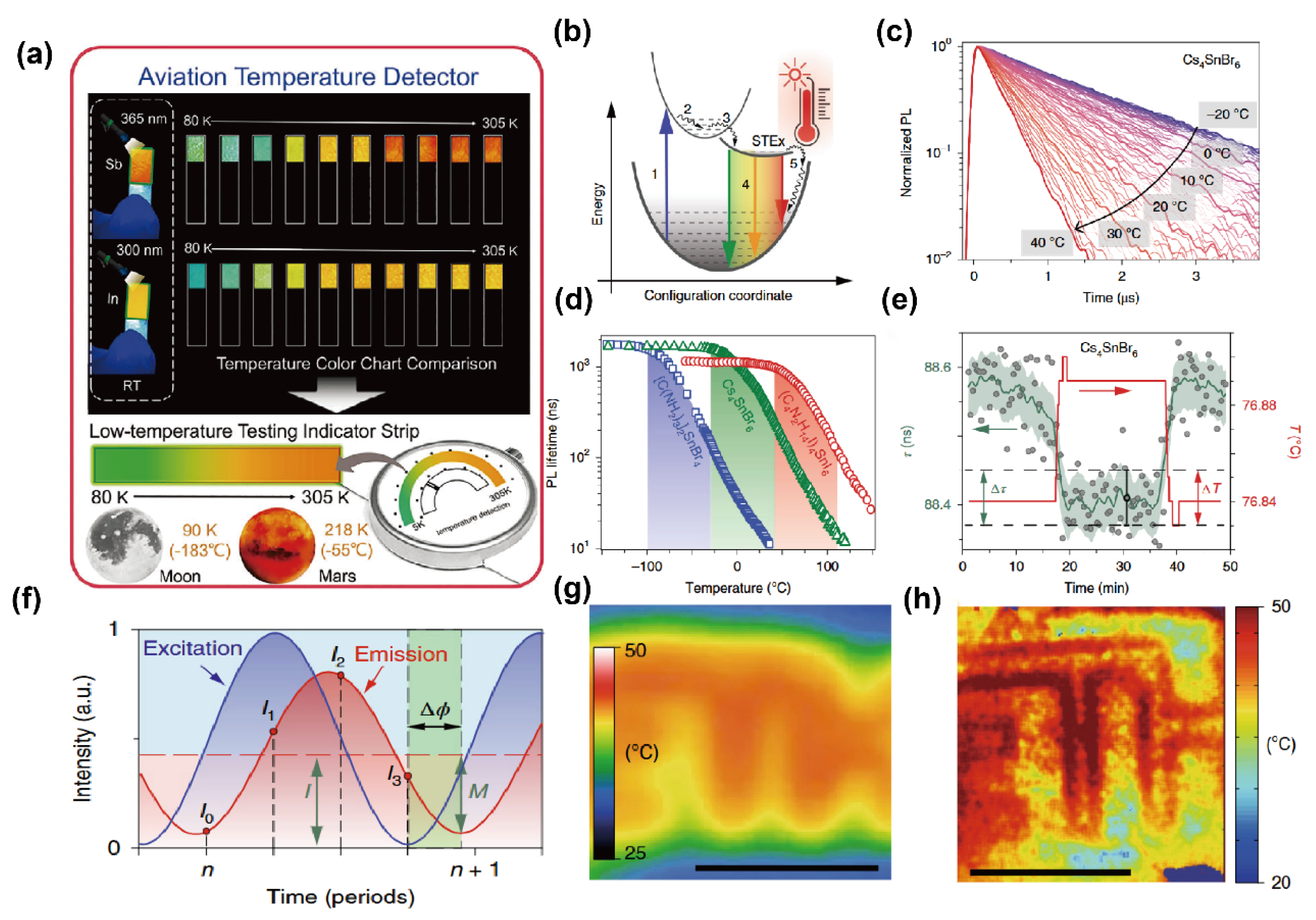
5.4. X-Ray Scintillation Imaging
6. Conclusions
Funding
Data Availability Statement
Conflicts of Interest
References
- Xuan, T.; Xie, R.-J. Recent Processes on Light-Emitting Lead-Free Metal Halide Perovskites. Chem. Eng. J. 2020, 393, 124757. [Google Scholar] [CrossRef]
- Zhou, C.; Xu, L.J.; Lee, S.; Lin, H.; Ma, B. Recent Advances in Luminescent Zero-Dimensional Organic Metal Halide Hybrids. Adv. Opt. Mater. 2020, 9, 2001766. [Google Scholar] [CrossRef]
- Yao, J.-S.; Wang, J.-J.; Yang, J.-N.; Yao, H.-B. Modulation of Metal Halide Structural Units for Light Emission. Acc. Chem. Res. 2021, 54, 441–451. [Google Scholar] [CrossRef]
- Han, Y.; Yue, S.; Cui, B.B. Low-Dimensional Metal Halide Perovskite Crystal Materials: Structure Strategies and Luminescence Applications. Adv. Sci. 2021, 8, 2004805. [Google Scholar] [CrossRef] [PubMed]
- Lin, H.; Zhou, C.; Tian, Y.; Siegrist, T.; Ma, B. Low-Dimensional Organometal Halide Perovskites. ACS Energy Lett. 2017, 3, 54–62. [Google Scholar] [CrossRef]
- Liu, D.; Dang, P.; Zhang, G.; Lian, H.; Li, G.; Lin, J. Near-Infrared Emitting Metal Halide Materials: Luminescence Design and Applications. InfoMat 2024, 6, e12542. [Google Scholar] [CrossRef]
- Zhang, F.; Lu, H.; Tong, J.; Berry, J.J.; Beard, M.C.; Zhu, K. Advances in Two-Dimensional Organic–Inorganic Hybrid Perovskites. Energy Environ. Sci. 2020, 13, 1154–1186. [Google Scholar] [CrossRef]
- Wang, S.; Zhu, H.; Sheng, M.; Shao, B.; He, Y.; Liu, Z.; Zhou, G. Advances of Low-Dimensional Organic-Inorganic Hybrid Metal Halide Luminescent Materials: A Review. Crystals 2025, 15, 364. [Google Scholar] [CrossRef]
- Lu, A.; Wu, Y.; Ji, Q.; Wang, J.; Ju, M.-G. Toward Tunable Low-Dimensional Metal Halide Perovskites with Functional Pseudohalides. Sci. Chin. Mater. 2024, 67, 2335–2344. [Google Scholar] [CrossRef]
- Mao, L.; Stoumpos, C.C.; Kanatzidis, M.G. Two-Dimensional Hybrid Halide Perovskites: Principles and Promises. J. Am. Chem. Soc. 2018, 141, 1171–1190. [Google Scholar] [CrossRef]
- Wu, Y.; Lu, S.; Zhou, Q.; Ju, M.G.; Zeng, X.C.; Wang, J. Two-Dimensional Perovskites with Tunable Room-Temperature Phosphorescence. Adv. Funct. Mater. 2022, 32, 2204579. [Google Scholar] [CrossRef]
- Hossain, A.; Bandyopadhyay, P.; Karmakar, A.; Ullah, A.K.M.A.; Manavalan, R.K.; Sakthipandi, K.; Alhokbany, N.; Alshehri, S.M.; Ahmed, J. The Hybrid Halide Perovskite: Synthesis Strategies, Fbrications, and Modern Applications. Ceram. Int. 2022, 48, 7325–7343. [Google Scholar] [CrossRef]
- Zhang, J.; Yang, X.; Deng, H.; Qiao, K.; Farooq, U.; Ishaq, M.; Yi, F.; Liu, H.; Tang, J.; Song, H. Low-Dimensional Halide Perovskites and Their Advanced Optoelectronic Applications. Nano-Micro Lett. 2017, 9, 36. [Google Scholar] [CrossRef] [PubMed]
- Chen, D.; Zou, G.; Wu, Y.; Tang, B.; Rogach, A.L.; Yip, H.L. Metal Halide Perovskite LEDs for Visible Light Communication and Lasing Applications. Adv. Mater. 2024, 1, 2414745. [Google Scholar] [CrossRef] [PubMed]
- Wu, Y.; Qiu, L.; Liu, J.; Guan, M.; Dai, Z.; Li, G. Narrow Bandgap Metal Halide Perovskites: Synthesis, Characterization, and Optoelectronic Applications. Adv. Opt. Mater. 2022, 10, 2102661. [Google Scholar] [CrossRef]
- Li, M.; Xia, Z. Recent progress of zero-dimensional luminescent metal halides. Chem. Soc. Rev. 2021, 50, 2626–2662. [Google Scholar] [CrossRef]
- Yan, J.; Li, H.; Aldamasy, M.H.; Frasca, C.; Abate, A.; Zhao, K.; Hu, Y. Advances in the Synthesis of Halide Perovskite Single Crystals for Optoelectronic Applications. Chem. Mater. 2023, 35, 2683–2712. [Google Scholar] [CrossRef]
- Han, K.; Jin, J.; Su, B.; Xia, Z. Molecular dimensionality and photoluminescence of hybrid metal halides. Trends Chem. 2022, 4, 1034–1044. [Google Scholar] [CrossRef]
- Yang, G.; Deng, C.; Li, C.; Zhu, T.; Liu, D.; Bai, Y.; Chen, Q.; Huang, J.; Li, G. Towards efficient, scalable and stable perovskite/silicon tandem solar cells. Nat. Photonics 2025, 19, 913–924. [Google Scholar] [CrossRef]
- Guo, K.; Lv, W.; Wang, H.; Li, M.; Xu, L.; Chen, R.; Xing, G.; Wu, G. Rational Engineering of Phase-Pure 2D Perovskite Solar Cells. Adv. Funct. Mater. 2025, 35, 2412482. [Google Scholar] [CrossRef]
- Sun, J.; Wang, K.; Ma, K.; Park, J.Y.; Lin, Z.Y.; Savoie, B.M.; Dou, L. Emerging Two-Dimensional Organic Semiconductor-Incorporated Perovskites horizontal line A Fascinating Family of Hybrid Electronic Materials. J. Am. Chem. Soc. 2023, 145, 20694–20715. [Google Scholar] [CrossRef]
- Cao, Q.; Li, P.; Chen, W.; Zang, S.; Han, L.; Zhang, Y.; Song, Y. Two-dimensional perovskites: Impacts of species, components, and properties of organic spacers on solar cells. Nano Today 2022, 43, 101394. [Google Scholar] [CrossRef]
- Yang, Y.; Du, K.; Zhou, C.; Xu, M.; Wang, J.; Xu, Y.; Dong, X.; Yuan, N.; Li, B.; Zhang, X.; et al. Buried Interlayer Induced 1D Perovskite Seeds Enable Over 31%-Efficiency Perovskite/TOPCon Tandem Solar Cells. Small 2025, 21, 2504346. [Google Scholar] [CrossRef] [PubMed]
- Duan, D.; Ge, C.; Rahaman, M.Z.; Lin, C.-H.; Shi, Y.; Lin, H.; Hu, H.; Wu, T. Recent Progress with One-Dimensional Metal Halide Perovskites: From Rational Synthesis to Optoelectronic Applications. NPG Asia Mater. 2023, 15, 8. [Google Scholar] [CrossRef]
- Boyd, C.C.; Cheacharoen, R.; Leijtens, T.; McGehee, M.D. Understanding Degradation Mechanisms and Improving Stability of Perovskite Photovoltaics. Chem. Rev. 2019, 119, 3418–3451. [Google Scholar] [CrossRef]
- Anoop, K.M.; Devadiga, D.; Sunitha, M.S.; Ahipa, T.N. Advancements in Preventing Sn2+ Oxidation in Tin-Based Perovskite Solar Cells: A Review. phys. status solidi 2025, 222, 2400569. [Google Scholar]
- Leung, T.L.; Ahmad, I.; Syed, A.A.; Ng, A.M.C.; Popović, J.; Djurišić, A.B. Stability of 2D and quasi-2D perovskite materials and devices. Commun. Mater. 2022, 3, 63. [Google Scholar] [CrossRef]
- Sun, S.; Lu, M.; Gao, X.; Shi, Z.; Bai, X.; Yu, W.W.; Zhang, Y. 0D Perovskites: Unique Properties, Synthesis, and Their Applications. Adv. Sci. 2021, 8, e2102689. [Google Scholar] [CrossRef] [PubMed]
- Nie, Z.; Yin, J.; Zhou, H.; Chai, N.; Chen, B.; Zhang, Y.; Qu, K.; Shen, G.; Ma, H.; Li, Y.; et al. Layered and Pb-Free Organic–Inorganic Perovskite Materials for Ultraviolet Photoresponse: (010)-Oriented (CH3NH3)2MnCl4 Thin Film. ACS Appl. Mater. Interfaces 2016, 8, 28187–28193. [Google Scholar] [CrossRef]
- Zhou, C.; Tian, Y.; Wang, M.; Rose, A.; Besara, T.; Doyle, N.K.; Yuan, Z.; Wang, J.C.; Clark, R.; Hu, Y.; et al. Low-Dimensional Organic Tin Bromide Perovskites and Their Photoinduced Structural Transformation. Angew. Chem. Int. Ed. 2017, 56, 9018–9022. [Google Scholar] [CrossRef]
- Wang, Z.X.; Li, P.F.; Liao, W.Q.; Tang, Y.; Ye, H.Y.; Zhang, Y. Structure-Triggered High Quantum Yield Luminescence and Switchable Dielectric Properties in Manganese(II) Based Hybrid Compounds. Chem. Asian. J. 2016, 11, 981–985. [Google Scholar] [CrossRef]
- Zhou, C.; Worku, M.; Neu, J.; Lin, H.; Tian, Y.; Lee, S.; Zhou, Y.; Han, D.; Chen, S.; Hao, A.; et al. Facile Preparation of Light Emitting Organic Metal Halide Crystals with Near-Unity Quantum Efficiency. Chem. Mater. 2018, 30, 2374–2378. [Google Scholar] [CrossRef]
- Kim, B.W.; Im, S.H. Supersaturated Antisolvent-Assisted Crystallization for Highly Efficient Inorganic Perovskite Light-Emitting Diodes. ACS Nano 2024, 18, 28691–28699. [Google Scholar] [CrossRef]
- Tavakoli, M.M.; Yadav, P.; Prochowicz, D.; Sponseller, M.; Osherov, A.; Bulović, V.; Kong, J. Controllable Perovskite Crystallization via Antisolvent Technique Using Chloride Additives for Highly Efficient Planar Perovskite Solar Cells. Adv. Energy Mater. 2019, 9, 1803587. [Google Scholar] [CrossRef]
- Jodlowski, A.D.; Yépez, A.; Luque, R.; Camacho, L.; de Miguel, G. Benign-by-Design Solventless Mechanochemical Synthesis of Three-, Two-, and One-Dimensional Hybrid Perovskites. Angew. Chem. Int. Ed. 2016, 55, 14972–14977. [Google Scholar]
- Palazon, F.; El Ajjouri, Y.; Bolink, H.J. Making by Grinding: Mechanochemistry Boosts the Development of Halide Perovskites and Other Multinary Metal Halides. Adv. Energy Mater. 2020, 10, 1902499. [Google Scholar] [CrossRef]
- Li, S.; Zhang, Y.; Sun, D.; Gao, B.; Zhang, B.; Yang, D.; Wang, Y. Low-Dimensional Organic–Inorganic Hybrid Metal Halide with Large Optical Anisotropy. Adv. Opt. Mater. 2025, 13, e01501. [Google Scholar] [CrossRef]
- Goetz, K.P.; Taylor, A.D.; Paulus, F.; Vaynzof, Y. Shining Light on the Photoluminescence Properties of Metal Halide Perovskites. Adv. Funct. Mater. 2020, 30, 1910004. [Google Scholar] [CrossRef]
- Tao, P.; Liu, S.-J.; Wong, W.-Y. Phosphorescent Manganese(II) Complexes and Their Emerging Applications. Adv. Opt. Mater. 2020, 8, 2000985. [Google Scholar] [CrossRef]
- Chen, X.; Che, M.; Xu, W.; Wu, Z.; Suh, Y.D.; Wu, S.; Liu, X.; Huang, W. Matrix-induced defects and molecular doping in the afterglow of SiO2 microparticles. Nat. Commun. 2024, 15, 8111. [Google Scholar] [CrossRef] [PubMed]
- Peng, H.; Zou, B. Effects of Electron−Phonon Coupling and Spin−Spin Coupling on the Photoluminescence of Low-Dimensional Metal Halides. J. Phys. Chem. Lett. 2022, 13, 1752–1764. [Google Scholar] [CrossRef]
- Sheikh, M.A.K.; Kowal, D.; Mahyuddin, M.H.; Cala’, R.; Auffray, E.; Witkowski, M.E.; Makowski, M.; Drozdowski, W.; Wang, H.; Dujardin, C.; et al. A2Bn–1PbnI3n+1 (A = BA, PEA.; B = MA; n = 1, 2): Engineering Quantum-Well Crystals for High Mass Density and Fast Scintillators. J. Phys. Chem. C. 2023, 127, 10737–10747. [Google Scholar] [CrossRef]
- Protesescu, L.; Yakunin, S.; Bodnarchuk, M.I.; Krieg, F.; Caputo, R.; Hendon, C.H.; Yang, R.X.; Walsh, A.; Kovalenko, M.V. Nanocrystals of Cesium Lead Halide Perovskites (CsPbX3, X = Cl, Br, and I): Novel Optoelectronic Materials Showing Bright Emission with Wide Color Gamut. Nano Lett. 2015, 15, 3692–3696. [Google Scholar] [CrossRef]
- Liu, Y.; Liu, G.; Wu, Y.; Cai, W.; Wang, Y.; Zhang, S.; Zeng, H.; Li, X. High-Temperature, Reversible, and Robust Thermochromic Fluorescence Based on Rb2MnBr4(H2O)2 for Anti-Counterfeiting. Adv. Mater. 2023, 35, 2301914. [Google Scholar] [CrossRef]
- Xue, S.H.; Shi, C.M.; Xu, L.J.; Chen, Z.N. Thermal and Vapor Induced Triple-Mode Luminescent Switch of Manganese (II) Halides Hybrid. Adv. Opt. Mater. 2024, 12, 2302854. [Google Scholar] [CrossRef]
- Lun, M.M.; Ni, H.F.; Zhang, Z.X.; Li, J.Y.; Jia, Q.Q.; Zhang, Y.; Zhang, Y.; Fu, D.W. Unusual Thermal Quenching of Photoluminescence from an Organic–Inorganic Hybrid [MnBr4]2−-based Halide Mediated by Crystalline–Crystalline Phase Transition. Angew. Chem. Int. Ed. 2023, 63, e202313590. [Google Scholar] [CrossRef]
- Liang, D.; Xiao, H.; Cai, W.; Lu, S.; Zhao, S.; Zang, Z.; Xie, L. Mn2+-Based Luminescent Metal Halides: Syntheses, Properties, and Applications. Adv. Opt. Mater. 2023, 11, 202202997. [Google Scholar] [CrossRef]
- Yang, L.; Liu, X.; Li, B.; Liu, Z.; Li, Y.; Shi, C.; Xu, Y. Emission Regulation in 0D Hybrid Copper Halides via Structural Transformation: From Defect to Non-Defect States for Information Encryption and Storage. Chin. Chem. Lett. 2025, 36, 110858. [Google Scholar] [CrossRef]
- Levine, I.; Menzel, D.; Musiienko, A.; MacQueen, R.; Romano, N.; Vasquez-Montoya, M.; Unger, E.; Mora Perez, C.; Forde, A.; Neukirch, A.J.; et al. Revisiting Sub-Band Gap Emission Mechanism in 2D Halide Perovskites: The Role of Defect States. J. Am. Chem. Soc. 2024, 146, 23437–23448. [Google Scholar] [CrossRef]
- Zhou, G.; Su, B.; Huang, J.; Zhang, Q.; Xia, Z. Broad-Band Emission in Metal Halide Perovskites: Mechanism, Materials, and Applications. Mater. Sci. Eng. R Rep. 2020, 141, 100548. [Google Scholar] [CrossRef]
- Gao, X.; Guo, F.; Chen, R.; Lin, F.; Li, Q.; Xu, D. Solvent Effects in Structural Engineering for Photoluminescent Low-Dimensional Metal Halides. Laser Photonics Rev. 2024, 18, 2400440. [Google Scholar] [CrossRef]
- Guo, Q.; Zhao, X.; Song, B.; Luo, J.; Tang, J. Light Emission of Self-Trapped Excitons in Inorganic Metal Halides for Optoelectronic Applications. Adv. Mater. 2022, 34, 2201008. [Google Scholar] [CrossRef]
- Jiang, F.; Wu, Z.; Lu, M.; Gao, Y.; Li, X.; Bai, X.; Ji, Y.; Zhang, Y. Broadband Emission Origin in Metal Halide Perovskites: Are Self-Trapped Excitons or Ions? Adv. Mater. 2023, 35, 2211088. [Google Scholar] [CrossRef]
- Zhou, L.; Liao, J.F.; Kuang, D.B. An Overview for Zero-Dimensional Broadband Emissive Metal-Halide Single Crystals. Adv. Opt. Mater. 2021, 9, 2100544. [Google Scholar] [CrossRef]
- Ran, Q.; Zhang, Y.; Yang, J.; He, R.; Zhou, L.; Hu, S. White-Light Defect Emission and Enhanced Photoluminescence Efficiency in a 0D Indium-Based Metal Halide. J. Mater. Chem. C. 2022, 10, 1999–2007. [Google Scholar] [CrossRef]
- Yan, S.; Tian, W.; Chen, H.; Tang, K.; Lin, T.; Zhong, G.; Qiu, L.; Pan, X.; Wang, W. Synthesis of 0D Manganese-Based Organic–Inorganic Hybrid Perovskite and Its Application in Lead-Free Red Light-Emitting Diode. Adv. Funct. Mater. 2021, 31, 2100855. [Google Scholar] [CrossRef]
- Jin, J.; Wang, Y.; Han, K.; Xia, Z. Rigid Phase Formation and Sb3+ Doping of Tin (IV) Halide Hybrids toward Photoluminescence Enhancement and Tuning for Anti-Counterfeiting and Information Encryption. Angew. Chem. Int. Ed. 2024, 63, e202408653. [Google Scholar] [CrossRef] [PubMed]
- Zhou, L.; Liao, J.F.; Huang, Z.G.; Wei, J.H.; Wang, X.D.; Li, W.G.; Chen, H.Y.; Kuang, D.B.; Su, C.Y. AHighly Red-EmissiveLead-Free Indium-Based Perovskite Single Crystal for SensitiveWater Detection. Angew. Chem. Int. Ed. 2019, 58, 5277–5281. [Google Scholar] [CrossRef]
- Zhou, Q.; Li, W.; Xiao, J.; Li, A.; Han, X. Low-Dimensional Metal Halide for High Performance Scintillators. Adv. Funct. Mater. 2024, 34, 2402902. [Google Scholar] [CrossRef]
- Kim, Y.H.; Kim, J.S.; Lee, T.W. Strategies to Improve Luminescence Efficiency of Metal-Halide Perovskites and Light-Emitting Diodes. Adv. Mater. 2018, 31, 1804595. [Google Scholar] [CrossRef] [PubMed]
- Liao, Q.; Jin, X.; Fu, H. Tunable Halide Perovskites for Miniaturized Solid-State Laser Applications. Adv. Opt. Mater. 2019, 7, 1900099. [Google Scholar] [CrossRef]
- Yao, J.; Xu, L.; Wang, S.; Song, J. Metal Halide Perovskites-Based White Light-Emitting Diodes. J. Phys. Photonics 2022, 4, 042001. [Google Scholar] [CrossRef]
- Wu, L.-K.; Li, R.-F.; Wen, W.-Y.; Zou, Q.-H.; Ye, H.-Y.; Li, J.-R. Lead-Free Hybrid Indium Perovskites with Near-Unity PLQY and White-Light Emission by Sb3⁺ Doping Strategy. Inorg. Chem. Front. 2023, 10, 3297–3306. [Google Scholar] [CrossRef]
- Zhou, B.; Qi, Z.; Dai, M.; Xing, C.; Yan, D. Ultralow-loss Optical Waveguides through Balancing Deep-Blue TADF and Orange Room Temperature Phosphorescence in Hybrid Antimony Halide Microstructures. Angew. Chem. Int. Ed. 2023, 62, e202309913. [Google Scholar] [CrossRef]
- Zhou, G.; Liu, Z.; Huang, J.; Molokeev, M.S.; Xiao, Z.; Ma, C.; Xia, Z. Unraveling the Near-Unity Narrow-Band Green Emission in Zero-Dimensional Mn2+-Based Metal Halides: A Case Study of (C10H16N)2Zn1–xMnxBr4 Solid Solutions. J. Phys. Chem. Lett. 2020, 11, 5956–5962. [Google Scholar] [CrossRef]
- Xue, S.-H.; Yao, J.-Y.; Xu, L.-J.; Chen, Z.-N. Advances in Electrically Driven Light-Emitting Diodes Based on Lead-Free Metal Halides. Chem. Commun. 2023, 59, 1116–1124. [Google Scholar] [CrossRef] [PubMed]
- Liu, A.; Bi, C.; Guo, R.; Zhang, M.; Qu, X.; Tian, J. Electroluminescence Principle and Performance Improvement of Metal Halide Perovskite Light-Emitting Diodes. Adv. Opt. Mater. 2021, 9, 2002167. [Google Scholar] [CrossRef]
- Wang, C.; Chen, S.; Jie, J.; Tian, C.; Jia, R.; Wu, X.; Zhang, X.; Zhang, X. Metal Halide Perovskite Single Crystals toward Electroluminescent Applications. Adv. Funct. Mater. 2024, 34, 2401189. [Google Scholar] [CrossRef]
- Liu, H.; Shonde, T.B.; Olasupo, O.J.; Manny, T.F.; Islam, M.S.; Viera, J.; Khizr, M.; Moslemi, S.; Lin, X.; Winfred, J.S.R.V.; et al. Solution Processed Bilayer Metal Halide White Light Emitting Diodes. Adv. Mater. 2024, 36, 2412239. [Google Scholar] [CrossRef]
- Zhou, T.; Wang, Y.; Zhou, L.; Wu, J.; Pan, Z.; Sun, F.; Gu, H.; Liu, R.; Ye, T.; Hou, J.; et al. Flexible Luminescent Fibers Based on Novel Antimony Halides Toward Advanced Anti-Counterfeiting and Information Encryption. Adv. Opt. Mater. 2025, 13, 2402641. [Google Scholar] [CrossRef]
- Zhang, K.; Zhou, X.; Li, S.; Zhao, L.; Hu, W.; Cai, A.; Zeng, Y.; Wang, Q.; Wu, M.; Li, G.; et al. A General Strategy for Developing Ultrasensitive “Transistor-Like” Thermochromic Fluorescent Materials for Multilevel Information Encryption. Adv. Mater. 2023, 35, 2305472. [Google Scholar] [CrossRef]
- Wei, J.H.; Yu, Y.W.; Luo, J.B.; Zhang, Z.Z.; Kuang, D.B. Bright Cyan-Emissive Copper(I)-Halide Single Crystals for Multi-Functional Applications. Adv. Opt. Mater. 2022, 10, 2200724. [Google Scholar] [CrossRef]
- Wang, Z.; Huang, X. Luminescent Organic-Inorganic Hybrid Metal Halides: An Emerging Class of Stimuli-Responsive Materials. Chem. Eur. J. 2022, 28, 202200609. [Google Scholar] [CrossRef] [PubMed]
- Liu, D.Y.; Li, H.Y.; Han, R.P.; Liu, H.L.; Zang, S.Q. Multiple Stimuli-Responsive Luminescent Chiral Hybrid Antimony Chlorides for Anti-Counterfeiting and Encryption Applications. Angew. Chem. Int. Ed. 2023, 62, e202307875. [Google Scholar] [CrossRef]
- Liu, K.; Liu, K.; Hao, S.; Hou, A.; Cao, J.; Quan, M.; Wang, Y.; Wolverton, C.; Zhao, J.; Liu, Q. Stimuli-Responsive Emission from Hybrid Metal Halides. Adv. Funct. Mater. 2024, 34, 2309296. [Google Scholar] [CrossRef]
- Jiang, L.; Wu, L.; Sun, H.; Yin, H.; Zou, Q.; Deng, J.; Li, R.; Ye, H.; Li, J. Antimony Doping towards Fast Digital Encryption and Decryption and High-efficiency WLED in Zero-Dimensional Hybrid Indium Chlorides. Chem. Eng. J. 2024, 494, 153060. [Google Scholar] [CrossRef]
- Zhou, G.; Wang, Y.; Mao, Y.; Guo, C.; Zhang, J.; Molokeev, M.S.; Xia, Z.; Zhang, X.-M. Temperature/Component-Dependent Luminescence in Lead-Free Hybrid Metal Halides for Temperature Sensor and Anti-Counterfeiting. Adv. Funct. Mater. 2024, 34, 2401860. [Google Scholar] [CrossRef]
- Hong, D.; Xu, X.; Song, X.; Zhang, L.; Sun, L.; Yuan, C.; Jiang, R. Emerging Metal Halide Perovskite for Photoluminescence Sensing: Transitioning Photophysics into Practical Applications. Chem. Eng. J. 2025, 505, 159092. [Google Scholar] [CrossRef]
- Yakunin, S.; Benin, B.M.; Shynkarenko, Y.; Nazarenko, O.; Bodnarchuk, M.I.; Dirin, D.N.; Hofer, C.; Cattaneo, S.; Kovalenko, M.V. High-resolution remote thermometry and thermography using luminescent low-dimensional tin-halide perovskites. Nat. Mater. 2019, 18, 846–852. [Google Scholar] [CrossRef]
- Chen, W.; Zhou, M.; Liu, Y.; Yu, X.; Pi, C.; Yang, Z.; Zhang, H.; Liu, Z.; Wang, T.; Qiu, J.; et al. All-Inorganic Perovskite Polymer–Ceramics for Flexible and Refreshable X-Ray Imaging. Adv. Funct. Mater. 2021, 32, 2107424. [Google Scholar] [CrossRef]
- Cui, H.; Zhu, W.; Deng, Y.; Jiang, T.; Yu, A.; Chen, H.; Liu, S.; Zhao, Q. Lead-Free Organic–Inorganic Hybrid Scintillators for X-ray Detection. Aggregate 2023, 5, e454. [Google Scholar] [CrossRef]
- Zhou, Y.; Chen, J.; Bakr, O.M.; Mohammed, O.F. Metal Halide Perovskites for X-ray Imaging Scintillators and Detectors. ACS Energy Lett. 2021, 6, 739–768. [Google Scholar] [CrossRef]
- Li, M.; Wang, Y.; Yang, L.; Chai, Z.; Wang, Y.; Wang, S. Circularly Polarized Radioluminescence from Chiral Perovskite Scintillators for Improved X-ray Imaging. Angew. Chem. Int. Ed. 2022, 61, e202208440. [Google Scholar] [CrossRef]
- Zheng, J.; Zeng, Y.; Wang, J.; Sun, C.; Tang, B.; Wu, Y.; Zhang, Y.; Yi, Y.; Wang, N.; Zhao, Y.; et al. Hydrogen-Rich 2D Halide Perovskite Scintillators for Fast Neutron Radiography. J. Am. Chem. Soc. 2021, 143, 21302–21311. [Google Scholar] [CrossRef]
- Xu, Y.; Li, Z.; Peng, G.; Qiu, F.; Li, Z.; Lei, Y.; Deng, Y.; Wang, H.; Liu, Z.; Jin, Z. Organic Cation Design of Manganese Halide Hybrids Glass toward Low-Temperature Integrated Efficient, Scaling, and Reproducible X-Ray Detector. Adv. Opt. Mater. 2023, 11, 2300216. [Google Scholar] [CrossRef]
- Zhao, W.; Wang, Y.; Li, R.; Liu, X.; Huang, W. Flash synthesis of high-performance and color-tunable copper(I)-based cluster scintillators for efficient dynamic X-ray imaging. npj Flex. Electron. 2024, 8, 77. [Google Scholar] [CrossRef]
- Meng, H.; Li, Y.; Zhang, F.; Niu, S.; Zhu, M.; Shi, Z.; Shen, G. Stable Organic-Inorganic Hybrid Sb(III) Halide Scintillator for Nonplanar Ultra-Flexible X-Ray Imaging. Adv. Funct. Mater. 2024, 35, 2412597. [Google Scholar] [CrossRef]
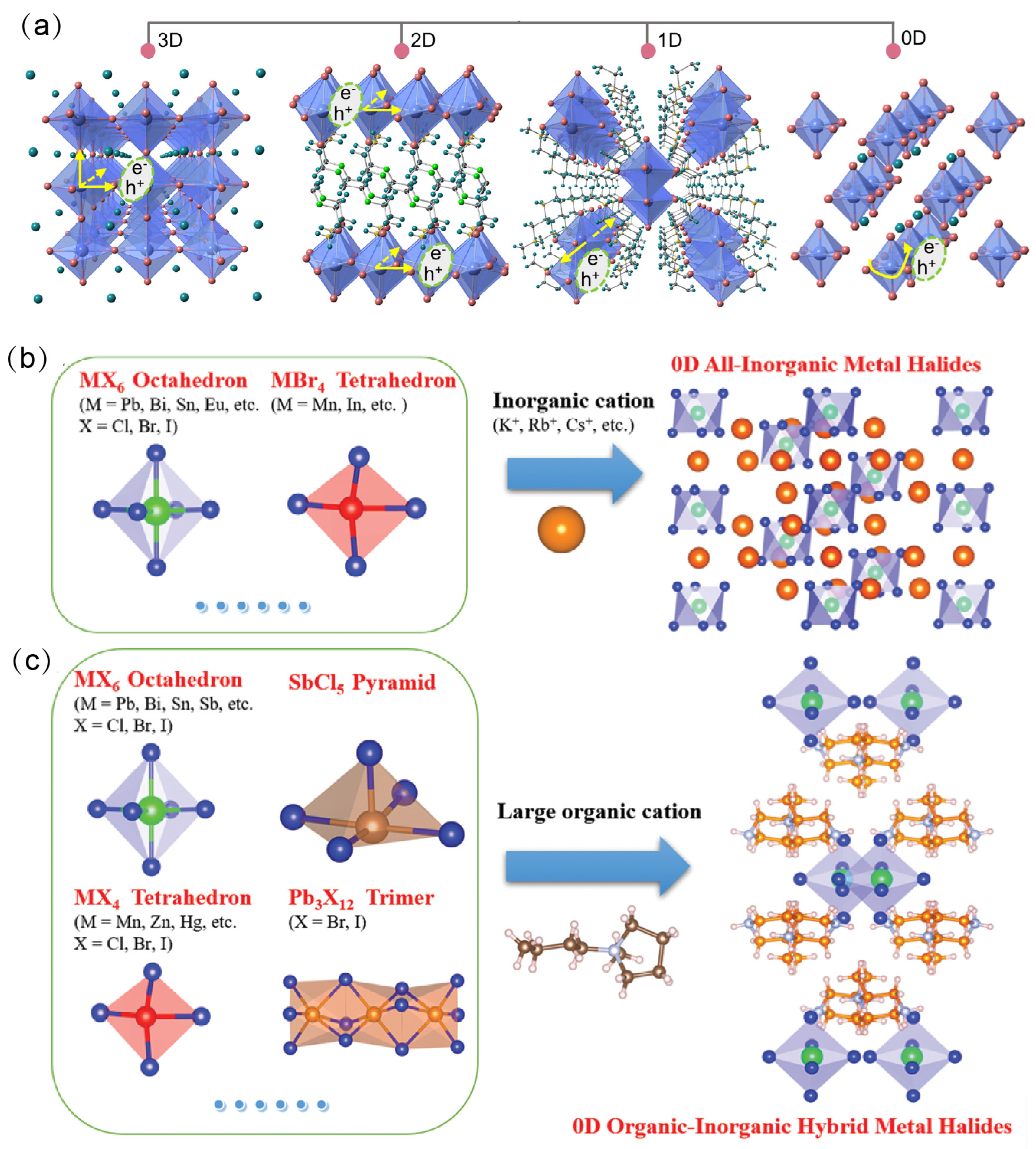

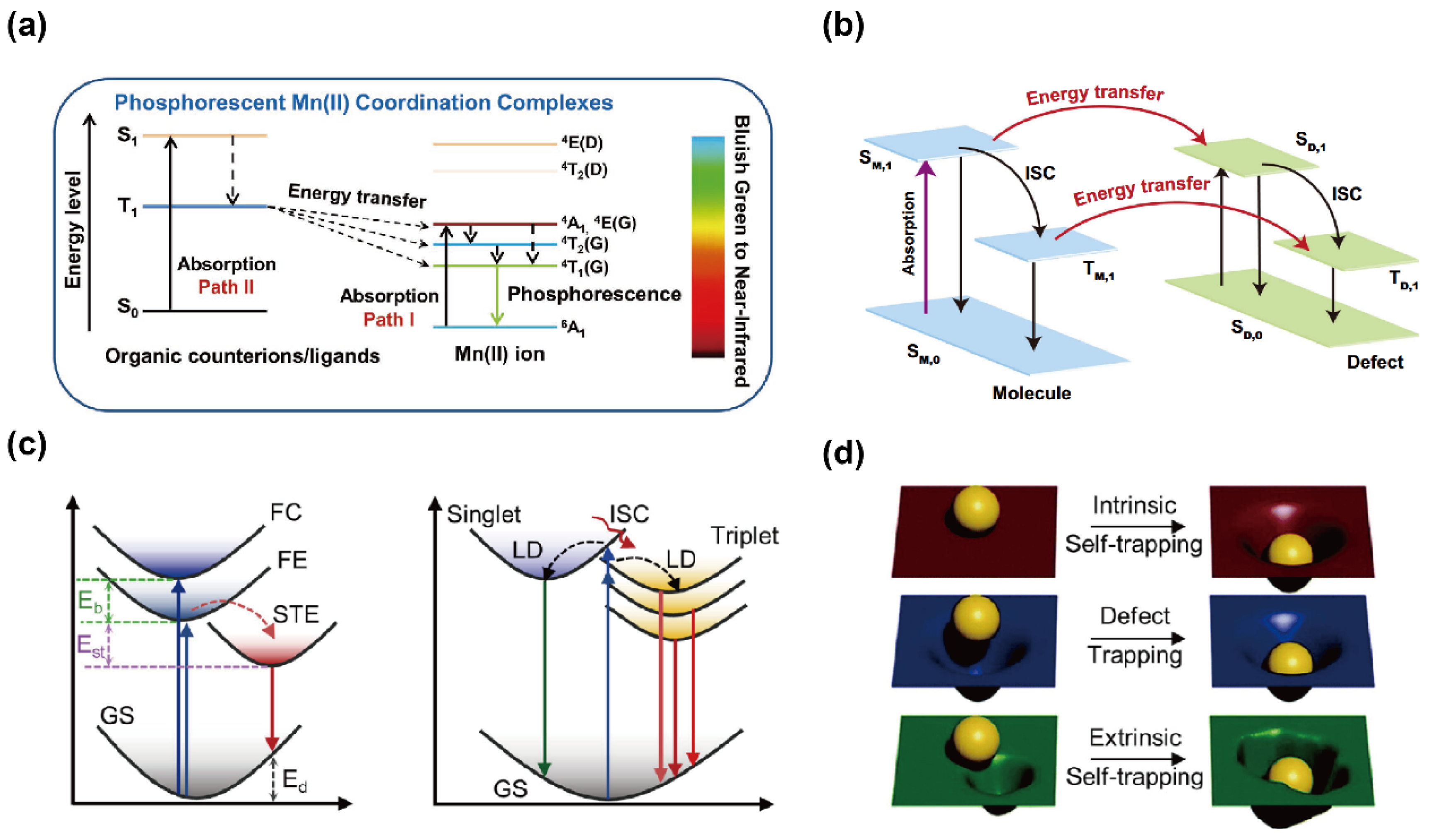
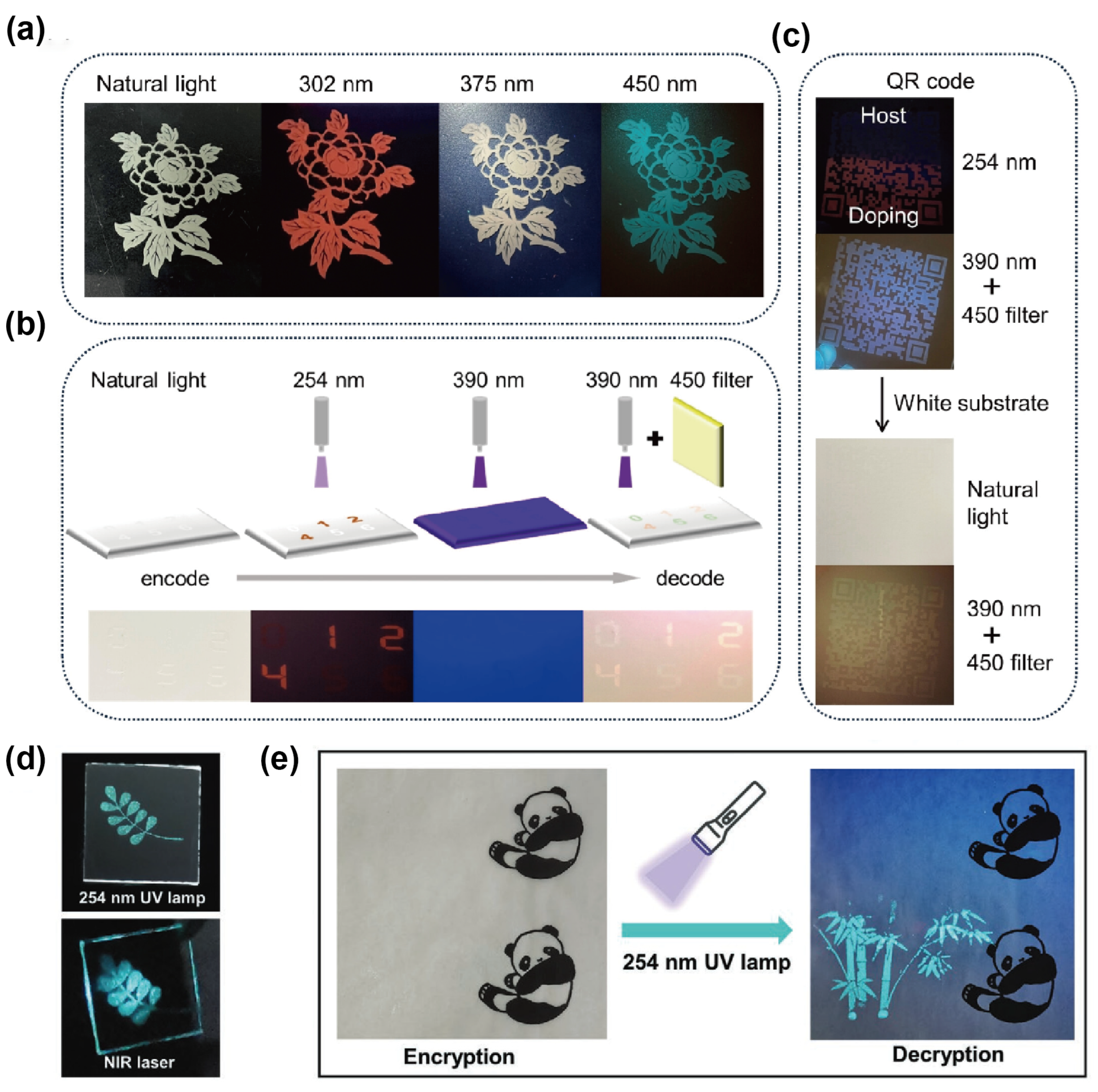


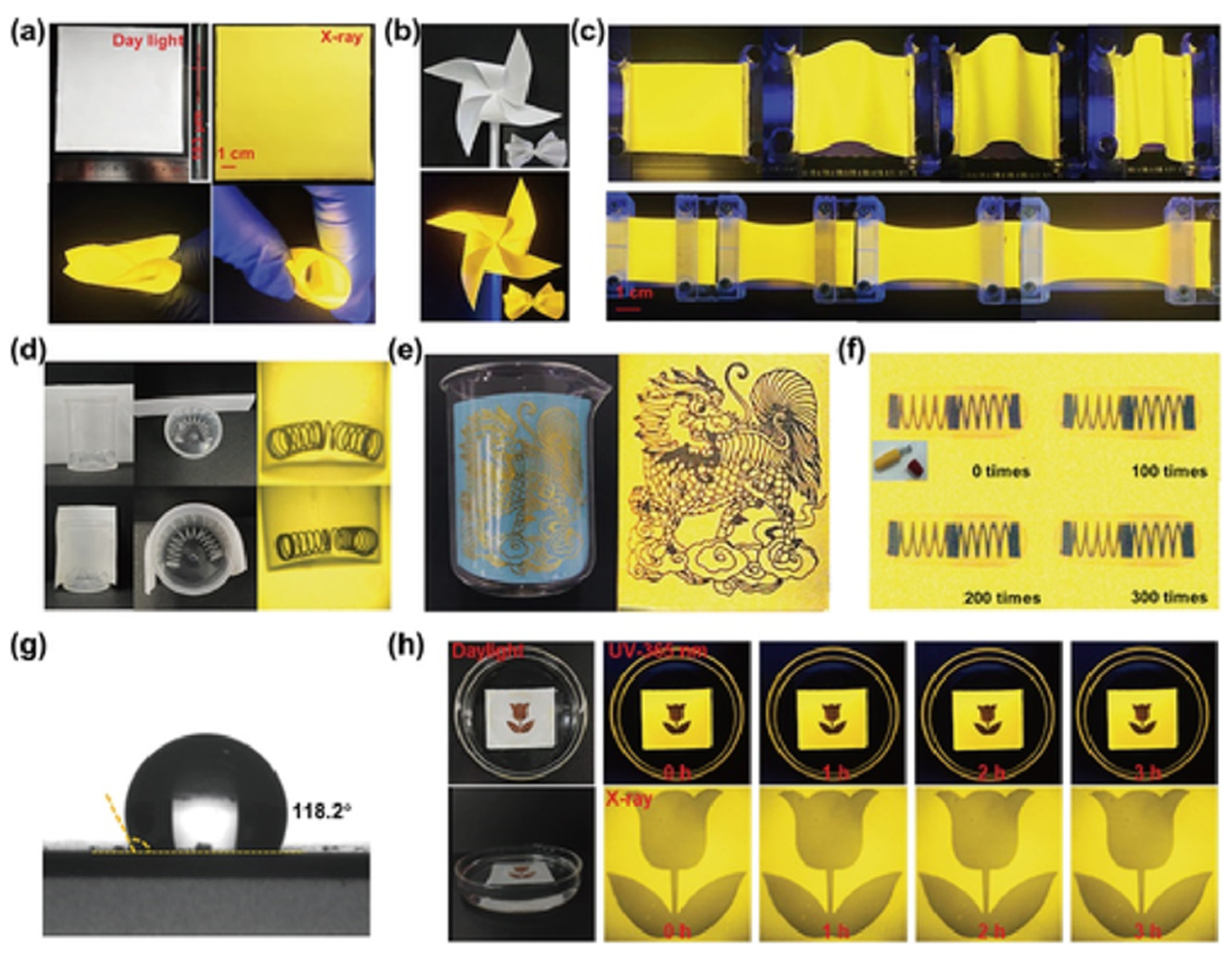
Disclaimer/Publisher’s Note: The statements, opinions and data contained in all publications are solely those of the individual author(s) and contributor(s) and not of MDPI and/or the editor(s). MDPI and/or the editor(s) disclaim responsibility for any injury to people or property resulting from any ideas, methods, instructions or products referred to in the content. |
© 2025 by the authors. Licensee MDPI, Basel, Switzerland. This article is an open access article distributed under the terms and conditions of the Creative Commons Attribution (CC BY) license (https://creativecommons.org/licenses/by/4.0/).
Share and Cite
Sheng, Z.; Wang, S.; Shao, B.; He, Y.; Liu, Z.; Zhu, H.; Sheng, Z. Synthesis, Photophysical Mechanisms, and Applications of Luminescent Organic–Inorganic Hybrid Metal Halides. Inorganics 2025, 13, 347. https://doi.org/10.3390/inorganics13110347
Sheng Z, Wang S, Shao B, He Y, Liu Z, Zhu H, Sheng Z. Synthesis, Photophysical Mechanisms, and Applications of Luminescent Organic–Inorganic Hybrid Metal Halides. Inorganics. 2025; 13(11):347. https://doi.org/10.3390/inorganics13110347
Chicago/Turabian StyleSheng, Zhenwen, Suqin Wang, Bo Shao, Yu He, Zhuang Liu, Hui Zhu, and Zhi Sheng. 2025. "Synthesis, Photophysical Mechanisms, and Applications of Luminescent Organic–Inorganic Hybrid Metal Halides" Inorganics 13, no. 11: 347. https://doi.org/10.3390/inorganics13110347
APA StyleSheng, Z., Wang, S., Shao, B., He, Y., Liu, Z., Zhu, H., & Sheng, Z. (2025). Synthesis, Photophysical Mechanisms, and Applications of Luminescent Organic–Inorganic Hybrid Metal Halides. Inorganics, 13(11), 347. https://doi.org/10.3390/inorganics13110347





